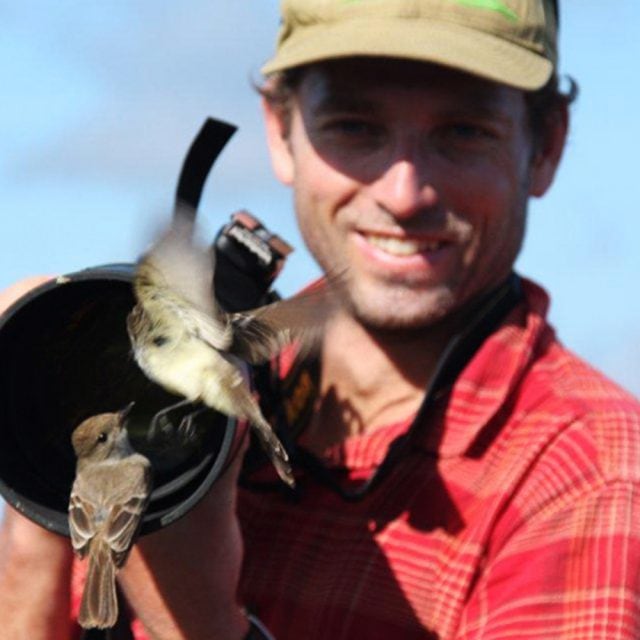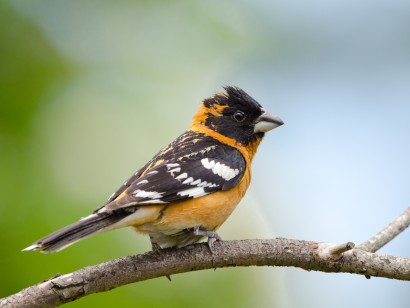Canadian Rockies: Waterton Trip Report (Jun 6 – 11, 2025)
June 7th
We began in Calgary, Alberta, meeting the night previous at our airport hotel. Three of twelve guests joined from the Birds and Dinosaurs tour and the rest of us from other parts of Canada (and two from Illinois!). The two guides, Arnaud (Montreal) and Steve (British Columbia) were excited to be leading the group.
In the morning our first stop was an alternative to the planned Kananaskis area, a detour imparted due to the high security of the upcoming G7 Summit. Horse Creek Marsh is an area of wet meadows where we kicked off our birding with some interesting species including Nelson’s and Clay-colored Sparrows, Wilson’s Snipe, and a rare (according to eBird) Broad-winged Hawk flying over.
From here we visited the nearby Bow Valley Provincial Park for lunch and a 1.5 hour walk on the Flowing Waters interpretive trail. Along here we heard and/or saw a few species of warblers including Magnolia, Northern Waterthrush and American Redstart. A Mountain Bluebird made a show just before we departed to Bragg Creek for an early dinner. On the way we stopped at Elbow Falls for a highlight hike to the falls and river, where Harlequin Duck and American Dipper put on a show. The latter was a pair of adults feeding two recently-fledged chicks. So cute!

Dippers at Elbow Falls © Steve Ogle

Birding at Elbow Falls © Steve Ogle
From Bragg Creek in the foothills we went east to Brown-Lowery Provincial Park for an out-and-back walk in coniferous forest. Due to the heat of the afternoon and some wind it was a fairly quiet walk and Evening Grosbeaks were the best encounter here. We had a late arrival in High River but with dinner already taken care of we were able to get to bed at a reasonable time. Still, it was a full day!
June 8th
We began the day at breakfast by doing our list from the previous day, then had a brief commute to Frank Lake. On the access road we saw our first Western Meadowlarks and a sneaky pair of Gray Partridge. A Cliff Swallow perched next to a Tree Swallow box. We checked out three different vantage points of the lake, scanning for all sorts of water birds. The most confiding were Eared Grebes, Wilson’s Phalaropes, and Yellow-headed Blackbirds that didn’t seem to mind a close approach. A few Sora popped out of the reeds admiring their reflections in the shallows. Western Grebes, American White Pelicans, Double-crested Cormorants and Forster’s Terns were distant attractions, while close-up looks and photos were offered by Black-necked Stilts, American Avocets, Ruddy Ducks, a Great Blue Heron and flyby Franklin’s Gulls. The only target species missing here were Willet and Marbled Godwit, two species we ended up finding at a back-up stop called Brant Colony Slough. Also located here was a pale “Richardson’s” Merlin.

Eared Grebe at Frank Lake © Steve Ogle

Sora at Frank Lake © Steve Ogle

Yellow-headed Blackbird © Steve Ogle
We opted for a lunch at the municipal campground in Nanton, which was a good choice given the much-desired combination of shade and birds. We added about ten new species for the trip, including Western Kingbird, Baltimore Oriole, Cedar Waxwing and Least Flycatcher. From here we directed ourselves toward Williams Coulee, a known location for Prairie Falcon. We had only stopped for a few minutes before seeing one of two pairs of this sleek cliff-nester displaying over the prairie. A Rock Wren was providing some musical ambiance and some people rappelling the cliffs made for additional entertainment. After some consultation with Jody Allair, who guided the earlier tour here, we ended up honing in on a few other raptors, including a pair of Golden Eagles, a nest of Ferruginous Hawk, and another surprise nest of Swainson’s Hawk only a metre from the side of the road! After this raptor extravaganza we headed down to Waterton Lakes National Park.

Western Kingbird © Steve Ogle

Prairie Falcon © Steve Ogle
June 9th
This morning we headed up early before breakfast to Cameron Lake, one of the few islands of still-green forest accessible after the large Kenow fire in 2017. It wasn’t long before the birds filled our fields of view: Olive-sided Flycatcher, Wilson’s and MacGillivray’s Warblers, Fox and White-crowned Sparrows, and Pine Siskin, among others. The postcard view of the lake and imposing cirque was clear and crisp, in contrast to yesterday’s smoky haze from wildfires to the north and east. Today was going to be very hot, and we suffered later, but the morning left its mark for cool mountain memories. After breakfast we journeyed to the Wishbone Trail for an out-and-back hike in the strengthening sun. Three of the highlights here were Black-headed Grosbeak, Ruffed Grouse and Gray Catbird. A while later we spent a few minutes at the Maskinonge Marsh lookout where we saw many Black Terns, several Trumpeter Swans and Sandhill Cranes. After this, we lunched at Cameron Falls, holding another pair of American Dippers and a fleeting glimpse of our only Western Tanager.

Our group at Cameron Lake © Steve Ogle

Small pond at Cameron Lake © Steve Ogle

Cameron Lake © Steve Ogle
From here we drove up to Red Rock Canyon for a hot, windy and mostly unproductive (for birds) walk. On the way we did stop at a stake-out location for Lazuli Bunting, and they did pop out despite the heat. One of the vans had a Dusky Grouse fly across the road. A final stop later in the afternoon was at the Hay Barn, where we had a calling Veery. Not even this musical songster could rouse us from our torpor, and with the temperature over 30C it was time to call it a day.

Waterton Lake © Steve Ogle
June 10th
Since we had a full experience in the Waterton area we decided to spend some precious hours out on the prairies. After breakfast we departed for Twin Rivers heritage rangeland to some shortgrass prairies. En route half of the group saw an American Badger. The first bird species we laid our eyes upon in the still-cool morning were displaying Chestnut-collared Longspurs and a male Long-billed Curlew, surely keeping guard over a nesting female. We relocated about a kilometre to search for Baird’s Sparrow and Thick-billed Longspur but only the latter appeared for a brief flyover. A Northern Harrier and Vesper Sparrow were other species recorded, prior to leaving for a Subway lunch in Cardston.

Long-billed Curlew © Steve Ogle

Birding on the prairie © Steve Ogle
Our last stop was Head-Smashed-In Buffalo Jump World Heritage Site. It’s beyond the scope of this summary to go into the details of the multi-tiered museum, mysterious cultural exhibits, enthusiastic interpretation and impressive biophysical attributes of this site, so it will have to suffice that it is a “must do!” Just the fact that a family of Great Horned Owls provided our last birding experience of the trip says enough. It capped off a great four days of birding with a wonderful landscape and an even better group of guests.

Great-horned Owls © Steve Ogle

Our group at Head-Smashed-In Buffalo Jump
Canadian Rockies: Waterton Lakes eBird list (Jun 6 – 11, 2025)




